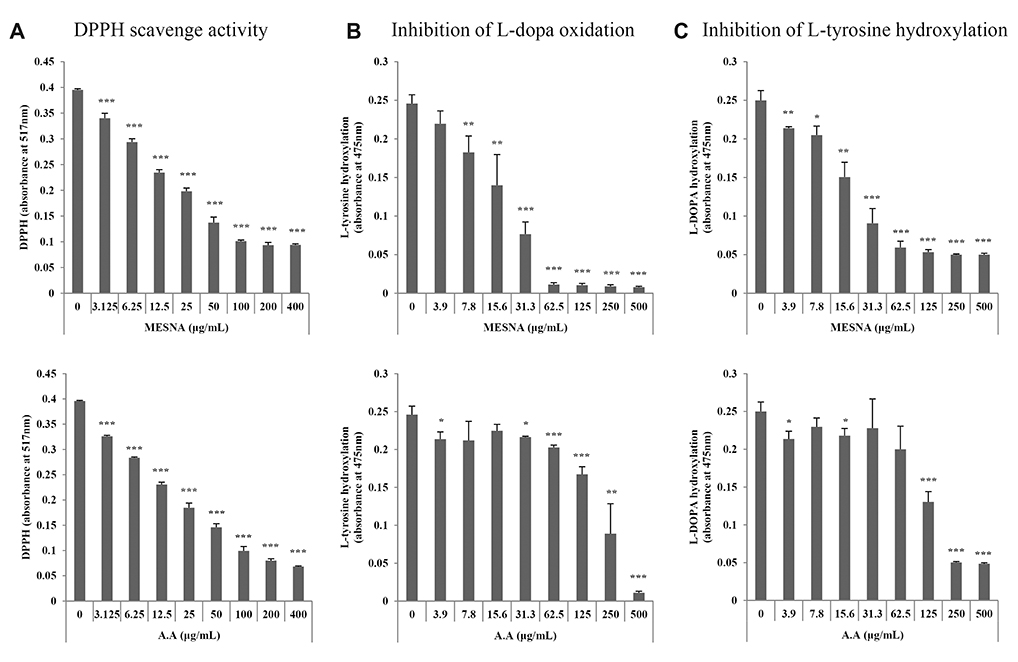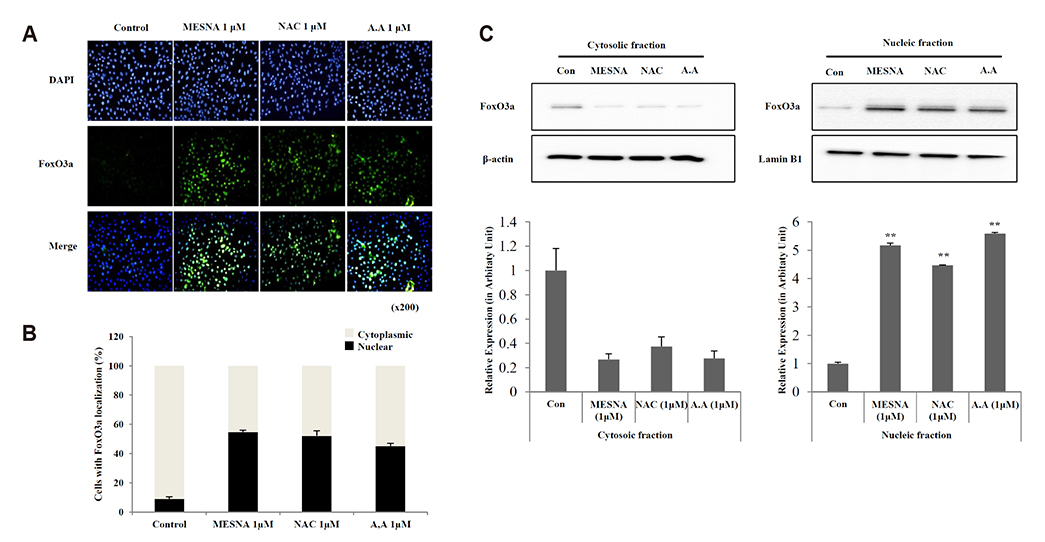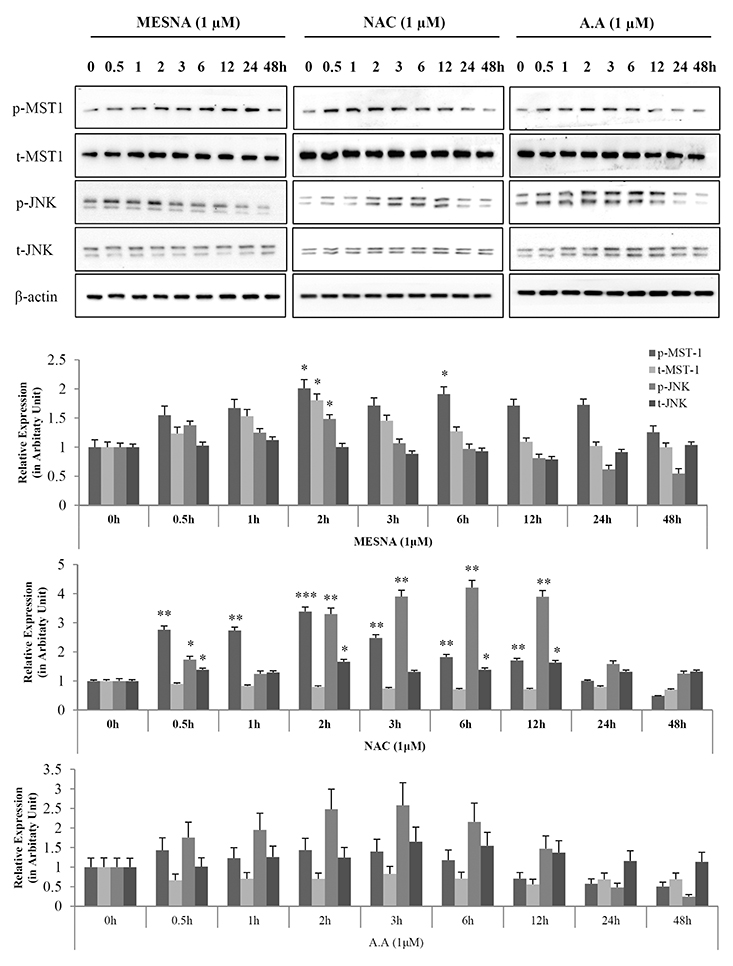Korean J Physiol Pharmacol.
2020 Mar;24(2):149-156. 10.4196/kjpp.2020.24.2.149.
Inhibition of melanogenesis by sodium 2-mercaptoethanesulfonate
- Affiliations
-
- 1R&D Unit, AmorePacific Corporation, Yongin 17074, Korea.
- 2Department of Dermatology, Chung-Ang University College of Medicine, Seoul 06974, Korea. beomjoon@cau.ac.kr
- 3Department of Medicine, Graduate School, Chung-Ang University, Seoul 06974, Korea.
- KMID: 2471036
- DOI: http://doi.org/10.4196/kjpp.2020.24.2.149
Abstract
- Sodium 2-mercaptoethanesulfonate (mesna) is a protective agent that is widely used in medicine because of its antioxidant effects. Recently, reactive oxygen species (ROS) were shown to increase pigmentation. Thus, ROS scavengers and inhibitors of ROS production may suppress melanogenesis. Forkhead box-O3a (FoxO3a) is an antimelanogenic factor that mediates ROS-induced skin pigmentation. In this study, we aimed to investigate the whitening effect of mesna and the signaling mechanism mediating this effect. Human melanoma (MNT-1) cells were used in this study. mRNA and protein expression were measured by real-time quantitative PCR and Western blotting analysis to track changes in FoxO3a-related signals induced by mesna. An immunofluorescence assay was performed to determine the nuclear translocation of FoxO3a. When MNT-1 melanoma cells were treated with mesna, melanin production and secretion decreased. These effects were accompanied by increases in FoxO3a activation and nuclear translocation, resulting in downregulation of four master genes of melanogenesis: MITF, TYR, TRP1, and TRP2. We found that mesna, an antioxidant and radical scavenger, suppresses melanin production and may therefore be a useful agent for the clinical treatment of hyperpigmentation disorders.
MeSH Terms
-
Antioxidants
Blotting, Western
Down-Regulation
Fluorescent Antibody Technique
Humans
Hyperpigmentation
Melanins
Melanoma
Mesna*
Negotiating
Pigmentation
Polymerase Chain Reaction
Reactive Oxygen Species
RNA, Messenger
Skin Lightening Preparations
Skin Pigmentation
Sodium*
Antioxidants
Melanins
Mesna
RNA, Messenger
Reactive Oxygen Species
Skin Lightening Preparations
Sodium
Figure
Reference
-
1. Masaki H. Role of antioxidants in the skin: anti-aging effects. J Dermatol Sci. 2010; 58:85–90.
Article2. Meister A. Glutathione-ascorbic acid antioxidant system in animals. J Biol Chem. 1994; 269:9397–9400.
Article3. Villarama CD, Maibach HI. Glutathione as a depigmenting agent: an overview. Int J Cosmet Sci. 2005; 27:147–153.
Article4. Kabasakal L, Sehirli AO, Cetinel S, Cikler E, Gedik N, Sener G. Mesna (2-mercaptoethane sulfonate) prevents ischemia/reperfusion induced renal oxidative damage in rats. Life Sci. 2004; 75:2329–2340.
Article5. Yilmaz ER, Kertmen H, Gürer B, Kanat MA, Arikok AT, Ergüder BI, Hasturk AE, Ergil J, Sekerci Z. The protective effect of 2-mercaptoethane sulfonate (MESNA) against traumatic brain injury in rats. Acta Neurochir (Wien). 2013; 155:141–149.
Article6. Sakuma K, Ogawa M, Sugibayashi K, Yamada K, Yamamoto K. Relationship between tyrosinase inhibitory action and oxidationreduction potential of cosmetic whitening ingredients and phenol derivatives. Arch Pharm Res. 1999; 22:335–339.
Article7. Kim J, Choi H, Cho EG, Lee TR. FoxO3a is an antimelanogenic factor that mediates antioxidant-induced depigmentation. J Invest Dermatol. 2014; 134:1378–1388.
Article8. Wang H, Gao XD, Zhou GC, Cai L, Yao WB. In vitro and in vivo antioxidant activity of aqueous extract from Choerospondias axillaris fruit. Food Chem. 2008; 106:888–895.9. Chang TS, Ding HY, Tai SS, Wu CY. Mushroom tyrosinase inhibitory effects of isoflavones isolated from soygerm koji fermented with Aspergillus oryzae BCRC 32288. Food Chem. 2007; 105:1430–1438.
Article10. Masamoto Y, Ando H, Murata Y, Shimoishi Y, Tada M, Takahata K. Mushroom tyrosinase inhibitory activity of esculetin isolated from seeds of Euphorbia lathyris L. Biosci Biotechnol Biochem. 2003; 67:631–634.11. Hosoi J, Abe E, Suda T, Kuroki T. Regulation of melanin synthesis of B16 mouse melanoma cells by 1 alpha, 25-dihydroxyvitamin D3 and retinoic acid. Cancer Res. 1985; 45:1474–1478.12. Yu T, Ji J, Guo YL. MST1 activation by curcumin mediates JNK activation, Foxo3a nuclear translocation and apoptosis in melanoma cells. Biochem Biophys Res Commun. 2013; 441:53–58.
Article13. Ura S, Masuyama N, Graves JD, Gotoh Y. MST1-JNK promotes apoptosis via caspase-dependent and independent pathways. Genes Cells. 2001; 6:519–530.
Article14. Skinner R, Sharkey IM, Pearson AD, Craft AW. Ifosfamide, mesna, and nephrotoxicity in children. J Clin Oncol. 1993; 11:173–190.
Article15. Choi J, Oh S, Lee D, Oh HJ, Park JY, Lee SB, Lim DS. Mst1-FoxO signaling protects Naïve T lymphocytes from cellular oxidative stress in mice. PLoS One. 2009; 4:e8011.
Article16. Sheth VM, Pandya AG. Melasma: a comprehensive update: part I. J Am Acad Dermatol. 2011; 65:689–697.17. Rivas S, Pandya AG. Treatment of melasma with topical agents, peels and lasers: an evidence-based review. Am J Clin Dermatol. 2013; 14:359–376.
Article18. Ros JR, Rodríguez-López JN, García-Cánovas F. Effect of L-ascorbic acid on the monophenolase activity of tyrosinase. Biochem J. 1993; 295 (Pt 1):309–312.
Article19. Huh CH, Seo KI, Park JY, Lim JG, Eun HC, Park KC. A randomized, double-blind, placebo-controlled trial of vitamin C iontophoresis in melasma. Dermatology. 2003; 206:316–320.
Article
- Full Text Links
- Actions
-
Cited
- CITED
-
- Close
- Share
- Similar articles
-
- Involvement of Transglutaminase-2 in alpha-MSH-Induced Melanogenesis in SK-MEL-2 Human Melanoma Cells
- Diarylpropionitrile inhibits melanogenesis via protein kinase A/cAMP-response element-binding protein/microphthalmiaassociated transcription factor signaling pathway in α-MSHstimulated B16F10 melanoma cells
- Effect of Hypoxia on the Melanogenesis of Murine B16 Melanoma Cells
- Piperine Regulates Melanogenesis through ERK Activation and Proteasomal Degradation of MITF
- ERK Activation by Fucoidan Leads to Inhibition of Melanogenesis in Mel-Ab Cells





